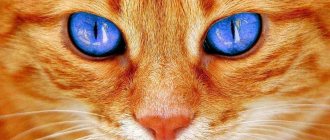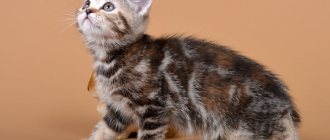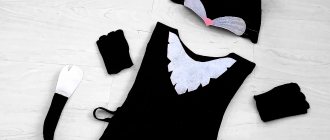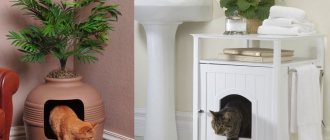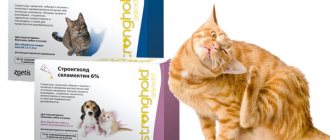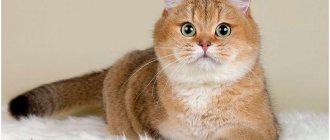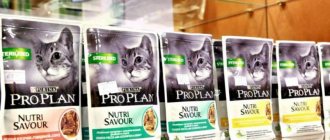The chocolate coloring of the native English breed is a unique phenomenon. It was one of the last to appear, and is allowed only in solid form, and traditionally is “capricious” - it tends to fade and change shade.
Outside of England and the USA, chocolate-colored Britons are rare, so they can confidently be called the “highlight” of the famous and ancient cat breed.
History of the origin of the Scottish Fold breed
The history of the origin of the Scottish Fold is quite unusual, because the breed was bred from a yard cat with long hair and unusually curved ears; at that time, this ear structure was considered a genetic mutation. In 1961, in Scotland, a shepherd interested in breeding cats noticed a white long-haired yard cat with an unusual ear shape. When the cat gave birth to kittens, he took one cat for himself, raised it and mated it with a British shorthair cat. As a result of this crossing, straight-eared and lop-eared kittens appeared.
Initially, the breed was simply called Fold; it received the Scottish prefix a little later in the place where it was bred. There are two types of the breed - short-haired and long-haired fold cats.
The breed was bred by a Scottish shepherd and got its name from the place where it was bred.
As a result of experiments with breeding Scottish fold cats, it was revealed that the mutation gene is dominant, which means that if one of the parents has the gene for folded ears, then kittens can appear with the same ears.
After some time, people in Scotland stopped breeding this breed out of fear that the mutation could have consequences in the form of ear infections or deafness in cats, which is why the breed was never officially recognized in Scotland. Active breeding of the breed began only in 1978 in the USA. In the same year, the breed was officially registered in one of the largest felinological organizations called CFA (Cat Fanciers' Association). The breed was never recognized by the International Federation of European Cat Breeding (FIFE) due to lop ears and associated mutations. But regardless of this, Scottish Folds are very popular in America and Australia.
Today, the Scots rank fourth in popularity among cat breeds, sharing it with the British Shorthair. The exotic cat, Persian and Maine Coon are ahead of them.
Shaded (shedded) colors
An unusual definition refers to the interesting color of Scottish cats - shaded colors. These pets have almost white fur, but the tip of the guard hair is colored.
The top layer of a cat's coat can be any shade typical of Scottish cats. The undercoat is white. The sides, back, head, tail and ears are shaded. Light belly, chin and lower tail. There should be no obvious spots. The “M” sign on the forehead and darkish rings on the paws are acceptable.
Shedded colors can be of three varieties:
Description of the fold breed
Scottish Folds are usually medium in size. The height at the withers of an adult is from 20 to 30 cm. The body is elongated, flexible, the tail is medium or long, depending on the proportions of the cat’s body. Weight is only 1.5–2 kg. The breed's ears look like a folded envelope, but there are three types:
- ears pressed firmly to the head;
Ears that are pressed tightly against the head require frequent care.
- less flattened ears;
- folded just half of the auricle.
The head is perfectly round. The eyes are large, the color most often depends on the coat color and varies from blue to amber-brown. The coat is soft, plush, and short.
The colors of the Scots are very different: blue, lilac, black, white, two-color, for example, Whiskas color - gray and white stripes all over the body or red and white, multi-colored (tortoiseshell - a combination of white, red and black).
Photo gallery: Scottish Fold cat colors
The monochromatic chocolate color of the fold cat does not allow undercoat of a different shade
Tortoiseshell colors are found in cats; for cats, this color is a genetic failure
The name of the popular "Whiskas" color - gray and white stripes - comes from a food advertisement
Most often, the color of a cat's eyes depends on the shade of its fur.
Newborn white kittens are allowed to have spots on their fur, but adults must be perfectly white
The long-haired Scottish cat is similar to the short-haired cat: medium-sized body, long tail, ears pressed to the head, huge eyes. The weight of an adult cat is from 3 to 8 kg. The cat is distinguished by its long, beautiful hair, which makes it look like a big fluffy ball.
The Highland Fold has long and beautiful hair, which is why it looks like a big fluffy ball.
Two-color
A unique coat color is bicolor (two-color cats). The main background is snow-white. The second color in color (cream, black, blue, red) is presented in the form of unusual patterns. Thoroughbred representatives must have white belly, neck, chest, paws, muzzle and beard.
A prerequisite is the predominance of a white background in color. Bicolors are more valued; their body patterns are symmetrical. The eyes can be any shade, but are usually blue or golden yellow.
Cream bicolor
Cute white cats with additional streaks of delicate cream tones. The eyes are blue or yellow, and the nose and pads are pink.
Blue bicolor
The pattern on the wool is blue (delicate or rich gray). The iris of the eyes is a beautiful sky tone or yellow-orange. The nose and paws below are pink.
Black bicolor
Black and white bicolor is characterized by patterns of rich black tone. These cats have a pink nose and blue or copper eyes. A symmetrical, distinct pattern on the skin turns the cat into a real gentleman in a tailcoat.
Character and behavior
Most often, most representatives of the breed are good-natured cats. But there are always exceptions to the rules - some fold-eared cats may have a wayward character, be unsociable, may not pay attention to the owner’s calls and may not even come up to be petted.
But in most cases, Scots love attention and affection, get along well in the family, get along with children and other animals, especially if they grew up together.
If you brought a new pet into your home, introduce them to the cat in doses so that the animals get used to each other and do not make each other want to fight.
Fold cats can treat strangers with caution and great caution, but once they realize that they are not in danger, they will easily make contact.
A fold-eared cat senses who its owner is, and it will not leave him even one step, in some cases it can even protect him from any danger. The breed is very active, loves to play with various teasing toys or simply chase a small ball or toy mouse. They can play on their own, but prefer human attention and participation in joint games. They also like to spend their rest next to a person, curling up in a ball and sometimes looking at what the person is doing.
Fold cats love to play, especially if the owner takes part in their games.
Diseases of the breed
The life expectancy of Scottish Fold cats is from 10 to 15 years. In order for your animal to live a long and healthy life, it is necessary to visit a veterinarian promptly, receive appropriate vaccinations, have joints checked, and follow the veterinarian's advice. The breed has some underlying health problems.
Hypertrophic cardiomyopathy
Hypertrophic cardiomyopathy is a hereditary heart disease. Symptoms:
- tachycardia;
- dyspnea;
- heavy breathing with wheezing;
- pulmonary edema;
- fainting;
- failure of the pelvic limb; in rare cases, both limbs may fail;
- high blood pressure.
The disease is diagnosed by measuring blood pressure at a veterinarian, undergoing echocardiography (data on the functionality of the heart is revealed), visual assessment, x-ray diagnostics, and electrocardiography. Animals in serious condition should be treated only in a hospital hospital, where there are all conditions for such cats. A veterinarian examines the animal’s condition and prescribes treatment, light physical activity and a special diet. If the animal feels better, it can be treated at home, unquestioningly following all the instructions of the treating veterinarian. The problem can be cured, but such cats will always have to be checked by veterinary cardiologists.
Degenerative joint disease
This disease is characterized by the fact that pain is present in the tail (most often) and the mobility of the limbs is reduced. Symptoms:
- obvious lameness;
- the cat’s reluctance to jump on chairs or sofas;
- it is difficult for a cat to get up from the floor after resting;
- frequent and prolonged licking of joints when washing;
- the cat becomes irritable and may hiss, scratch or bite.
The disease is treated with anti-inflammatory non-steroidal drugs; if the disease is advanced, antibiotics are prescribed. Additionally, a diet may be prescribed.
Osteochondrodysplasia
It is expressed in deformation of the paws, skeleton, and immobility of the tail. Symptoms:
- lameness (may pass and reappear, and an animal with illness will not be able to jump on high ground);
- squat appearance;
- stiff gait;
- acute reaction to touching the tail;
- severe deformation of the hind limbs;
- unsteady gait.
Treatment is aimed at eliminating symptoms with medication. In the absence of polycystic kidney disease, a non-steroidal anti-inflammatory drug can be prescribed; it will relieve the cat of pain and reduce inflammation. Additionally, vitamin complexes and special supplements are prescribed. In the UK, such sick cats undergo irradiation of their extremities; for a long time the cat can calmly walk, run and jump. In Russia there are no such technologies, so such operations are not carried out.
The disease often occurs when two fold-eared cats are crossed. From such parents there will be sick offspring with problems with the musculoskeletal system and skeletal structure.
Color-pont
This type of color is considered rare among Scottish Fold cats. Folds owe their elite coloring to their British ancestors, who had Persians with a similar color in their family. The cat's body is light, and all protruding parts (ears, muzzle, tail, paws) are painted in brighter colors, forming an effective contrast with the main color shade.
Choosing a Scottish Fold kitten
If you want an animal for exhibitions and further breeding, then look for a kitten in elite nurseries. Most have websites on the Internet where you can see reviews, the animals themselves, information about the breeder and other useful things. If you just need a pet for the soul, then you can look for a pet on websites with advertisements.
Regardless of what purpose you need the animal for, first of all pay attention to the appearance and behavior of the kittens. Healthy kittens are active, with soft fur and non-running eyes. If the kitten is lethargic, then this is a sure sign of some kind of illness. Ask the breeder to show you the kittens' parents - you can roughly imagine what the kitten will look like in the future.
When choosing a kitten, you need to pay attention to activity: the more active the animal, the healthier it is.
Ask about the age of the kittens. The best age for selling offspring is 3 months, at this time the kittens are already quite independent: they eat, wash themselves, play and go to the toilet. Ask the breeder about documents: veterinary passport and pedigree (if available and you need).
The veterinary passport must contain notes on the animal’s vaccination, as well as notes on the treatment of the kitten for helminths.
If there are a lot of kittens, then watch them; the characteristics of their character or behavior will help you choose exactly the kitten that will suit you. When choosing a gender, think about it: if you want to mess with small kittens, then choose a cat - there are fewer problems with them, they will not mark every corner, unlike cats. If you want a cat, then be prepared for the fact that he may mark sofas, carpets or curtains. In addition, it is worth deciding whether you will spay/neuter your animal.
Prices for fold-eared kittens depend on the availability of pedigree, color and coat length. Long-haired Scottish Folds cost twice as much as short-haired ones. A kitten without a pedigree costs from 3 to 6 thousand rubles, with a pedigree - from 10 to 40 thousand rubles.
Distinctive features of this breed:
- soft plush fur;
- ears pressed to the head;
- unusual coat color;
- short hair in Scottish Folds, long hair in Highland Folds;
- small but elongated body, small tail;
- All kittens have blue eye color, the shade changes with age;
- at three months, the kitten weighs no more than 500 g, and its height at the withers is about 15 cm.
How to care for a kitten
When you bring your new pet home, make sure he has everything he needs. This includes:
- house;
- toilet;
- bowls for food and water;
- comb for cats;
- toys.
A small kitten requires increased attention to itself. In the first week he may be intimidated and unsociable, this is explained by the change of place, over time he will get used to it. At first, food, a house and a toilet should be nearby so that the animal does not get lost and make a puddle on the carpet.
The kitten should be fed in small portions, from 2 to 6 months at least five times a day. Clean, fresh, unboiled water should always be available. You can bathe the animal once every three or four months as it gets dirty, the ears should be cleaned as they get dirty, don’t forget about the eyes, from which tears can flow, they can be wiped with a cotton pad.
Scottish Fold ears need to be cleaned twice a week.
Once a quarter, the kitten must be treated against fleas, ticks and worms with special veterinary medications.
If desired, you can accustom your animal to brushing its teeth from a young age using a toothbrush and toothpaste for cats.
How to choose a name for a kitten
When coming up with a nickname for an animal, you should adhere to some rules:
- do not give the animal a long name;
- to choose a suitable nickname, observe the kitten, its character and activity - most often it is from these features that the name for the pet is invented;
- if you have a child, you can let him come up with a nickname for the cat, probably in the child’s memory there are many cartoon names that may suit your pet.
You can choose a name for a kitten based on its color. For example, a white girl can be called Snowball, Blondie, Jasmine, and a white boy can be called Snowball, Percy, Pooh, Marshmallow, Santa. A red-haired girl can be called Squirrel, Fox, Toffee, Sonya, a red-haired boy can be called Fox, Garfield, Ogonyok. With black cats, everything is generally simple, a girl - Blackie, Puma, Bagheera, Gloom, Voodoo, a boy - Morphy, Inferno, Motty, Mystic.
You can choose a name for a cat based on its coat color, for example, a red cat can be called Sonya, Ryzhulya, Fox
If you want to choose an unusual name for a kitten, you can use a special book with names for cats. Here are some examples of what you can call a fold-eared cat: Diana, Zabava, Auri, Bianka, Gabby, Aina, Gressy, Vasilisa, Holly, Erica, Laffey, Alice, Yanette. Names for the cat: Archie, Weiss, Douglas, Aston, Mustang, Baron, Woland, Chucky, Chip, Caesar, Quentin, Prince, Willis.
Wang
The Van coloring of Scottish pets includes a white coat with a colored tail and several spots on the head. If there are large spots on the paws and back, this is considered an undesirable sign for a purebred Scot. And a cat with dark red patterns is called a red van.
The color of the spots can be single-color or tabbed.
Breed care
A fold-eared cat should be bathed no more than once every 3-4 months, or when it gets dirty. Use cat shampoo when bathing, after bathing, dry the cat with a towel and preferably dry it with a hairdryer, especially in winter, so that the animal does not catch a cold.
I bathe my cat once every three months, drying it with a hairdryer each time so that this wet creature does not fall onto a clean bed or get dust or other dirt on itself. Considering that my cat loves to lie in a large flower pot on the ground, drying with a hairdryer is a salvation from dirty paws and repeated bathing.
The fold-eared cat is the only one of all breeds that loves to be scratched against the grain. For combing, you can buy a comb with metal tips, but under no circumstances a slicker brush. A slicker can ruin the Scottish coat, and it will turn from plush to cotton wool, and the cat will lose its beautiful appearance. Long-haired cats need to be brushed once a day. Highland Folds do not like to swim, so once every 6 months will be enough.
Since the breed has floppy ears, cleaning should be done more often than regular cats. This is done twice a week using a cotton swab and ear drops for cats. The claws are trimmed as they grow back with special scissors; they remove the very tip of the claws.
When cutting, the main thing is not to touch the blood vessel in the claw.
cat litter
First you need to find a place for the cat litter box. Most often, owners choose a bathroom or toilet for these purposes; in some cases, it may be a corridor or landing on the stairs in a private house. For small kittens, the tray should be placed next to the house, and then, as they grow, you can move the tray to where it is convenient for you.
You also need to choose a litter tray for your pet. They come in three varieties:
- open with bars;
- open without grate, but with filler;
- Eurotoilet.
The Eurotoilet looks nice and is easy to clean
For a closed Euro-toilet you need a gel or silicate filler, their price is rather high, but the fillers block unpleasant odors, the tray itself looks nice, the filler does not scatter on the floor; The disadvantage of such a toilet is the large size of the tray, which may not fit in a small apartment.
A tray with filler is also very convenient: the tray itself is inexpensive, you can choose any filler for it according to your taste and wallet size, and it is convenient to change such a tray.
Ideal for cats - a large tray with filler
In my opinion, the most convenient filler is wood. You can find it in any store, it is inexpensive, and the filler lasts a long time. Absorbs liquid well, locking in odors. And cats find it more pleasant to walk on wood filler than on silicate balls or small pebbles.
For those people who are often at home and do not want to spend money on constantly buying fillers, we can recommend a simple tray with a mesh. It is convenient to rinse such a pot with water and wash it once a week with a chlorine-containing product to clean the tray and remove all odors.
To choose a filler, you often have to experiment. Each kitten has its own needs, some will like to use wood litter, some will like silicate litter, and some kitten will not like the litter and will only go to an empty tray with a grid.
This is exactly what happened with my cat. When I brought it home, I immediately put out a tray with wood filler. She showed him where his tray was and put him in it. The cat refused to go there for a day and endured it. Then I decided to remove the filler and leave the tray empty. I immediately went about my business and was pleased. So you should choose a toilet taking into account the cat’s characteristics and desires.
Feeding the fold breed
You need to feed the animal depending on its age:
- from 2 to 6 months - 5 times a day;
- from 6 to 8 months - three times a day;
- after eight months - twice a day.
The portion should be medium, you can find out its size by watching how much your pet eats. If the food is dry, then you can put more, the animal will still eat it later, but this option will not work with natural food, because it can turn sour throughout the day.
If you decide to feed your cat dry ready-made food, then it must be premium class, preferably for Scottish Folds. Dry food contains all the nutrients, vitamins and minerals that are useful and necessary for cats. Cats do not develop allergies to this food, and due to its balance, the cat quickly fills up with a small portion of dry food.
If you don’t want to give your cat dry food, you can feed it natural food. The diet should contain:
- sea fish;
- porridge;
- chicken;
- beef;
- turkey;
- cheese;
- cottage cheese;
- raw egg yolks;
- liver;
- vegetables.
It is not recommended to give to Scots:
- legumes;
- pork;
- potato;
- lamb;
- onion;
- milk;
- duck;
- sweet;
- salty and spicy foods;
Food from the human table should never be given to cats.
- salty preserves;
- chicken or fish bones;
- sausage;
- smoked meats;
- river fish;
- egg whites.
Sometimes I give my cat sour milk or a little yogurt. Such products can be given to fold-eared cats, but in small quantities and infrequently. It’s better to leave cheese as a treat, otherwise the animal will not want to eat porridge or vegetables when there is plenty of tasty cheese.
How to choose a kitten
Everyone knows that the problem of choice is not easy in itself. And if you choose a Scottish fold cat as a pet, you need to approach the issue very responsibly.
- Firstly, you can take a kitten from its mother no earlier than the baby reaches the age of 11-13 weeks. This time is enough so that, on the one hand, the kitten can receive all the vital antibodies and nutrients with milk, and on the other hand, it can sufficiently adapt to independent life (eat a variety of food, go to the litter box). It is also very important that by this time an experienced and responsible breeder will have already given the kittens the first required vaccinations. If you want to make a choice earlier than the specified period, you can always arrange a viewing with the owner of the mother cat.
- Secondly, it is very important to remember that characteristic lop ears are the result of a gene mutation, to prevent the negative consequences of which one of the parents must be straight. Compliance with this mating rule can only be guaranteed by professional breeders or specialized breeding nurseries. Buying a visloushka on the market or from random people is absolutely unacceptable.
You have come for a kitten. What should you pay attention to?
Fold kitten
- Baby's tail. The Fd mutation gene, which leads to lop ears, has its effect on the cartilage tissue of other parts of the body, so the tail of a healthy kitten from the “correct” parents should be quite flexible, active, without visible creases or thickenings.
- Behavior of a small Scottish Fold. It is better to buy a kitten that is confident, active and inquisitive. You should not hope that a frightened animal that does not come into your arms and hides in a corner will adapt well and quickly in your home, even if you are persistently convinced of this.
- Don’t hesitate to look under the animal’s tail – it should be dry and clean. The absence of odor from the mouth, discharge from the ears and eyes are signs of a healthy baby.
- Look at the parents of the kittens, find out in what conditions the animals are kept.
When taking your baby home, do not hesitate to ask the breeder all the questions that interest you. And there are many of them: what is the best way to feed kittens, where and when to get vaccinated, what are the main points to consider when caring for your little pet. The information received will help you properly organize the process of getting your baby accustomed to your home and make it as painless and comfortable as possible for both parties.
Breeding Scottish Fold cats
Puberty in cats begins at approximately eight months. It’s best to skip the cat’s first heat, but on the second, after a year, you can safely pair her with a cat. If you have a fold-eared cat, then you should breed her with a straight-eared Scottish cat (Scottish Straight) to avoid health problems in the offspring.
Pregnancy in cats lasts 63–67 days. In Scottish cats, pregnancy proceeds well; cats at this time become lazier, sleep and eat more. Often, during estrus or pregnancy, fold-eared cats' ears rise slightly; over time, they fall into place; this phenomenon is not considered a flaw. A fold-eared cat can give birth to from one to seven kittens.
All offspring are born with straight ears, and it is possible to understand who will have fold ears only at 2–4 weeks of life.
Initially, all kittens are born with straight ears, and only by the age of two weeks can you understand which kitten will be straight-eared and which will have fold ears
Most often, Scottish cats are good and caring mothers. They raise their kittens, feed them, lick them, and over time teach them how to wash themselves, play, where to go to the toilet, and where to sharpen their claws.
Castration and sterilization
Sterilization and castration can be performed on both male and female cats, the difference is in the procedure itself. Sterilization involves ligation of the fallopian tubes in cats, and ligation of the seminal ducts for cats. The operation does not affect the sexual desire of animals, their instincts do not decrease or lose their intensity, animals can mate, but cease to bear offspring. Castration is the complete surgical removal of all reproductive organs: in cats, the ovaries are removed along with the uterus or just the ovaries alone; in cats, both testicles are removed.
An operation to sterilize or castrate an animal can be performed no earlier than puberty (8–10 months) and throughout its life. Not before maturity, because at a young age the reproductive system of animals is not yet fully developed and surgery can only harm their health.
After sterilization, cats require increased attention and proper care.
The operation is performed by a veterinarian under general anesthesia. The operation is short and quite simple. After the procedure, observation and care of the animal is necessary:
- Immediately after the operation, you need to monitor your pet, its breathing, and its general condition.
- Arriving home, the animal should be placed on a warm bedding away from windows and doors so that there is no draft.
- When the cat recovers from anesthesia, you need to put clean water nearby; you can feed it only a day after the operation in small portions and preferably with something liquid, like broth.
- Treat a cat’s wound with stitches for the first two days with brilliant green once a day, after that with Chlorhexidine two or three times a day, after 10–12 days the stitches are removed.
Chinchillas
The Scots owe such expressive and beautiful colors to the British, who, in turn, borrowed it from the exotics and Persians. This rare color is found only if both the mother and father of the kitten are chinchillas. It is characterized by one-tone coloring of 1/8 of the coat area, the other areas of the coat are white.
Classification:
- Silver chinchilla. A peculiar combination of light undercoat and black “shading”. Snow-white ears, tummy.
- Golden. Individual areas of the body are “shaded” with intense fiery red. Tipped paws, muzzle.
- Golden (blue). The rare coloring is formed by the “baked milk” undercoat and bluish tipping with a shimmering shine.

